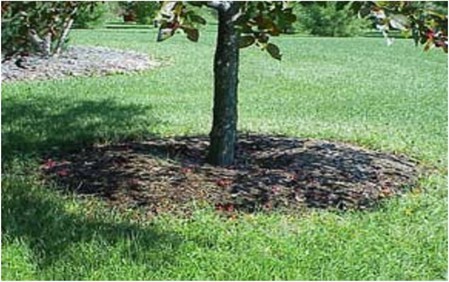Mulch the Right Way

Mulches provide many benefits for trees and shrubs: moderate soil temperatures, reduce soil moisture loss, reduce soil compaction, provide nutrients, improve soil structure, keep mowers and string trimmers away from the trunk. These benefits result in more root growth and healthier plants. When applying mulch, the following guidelines should be observed:
The best mulch materials are wood chips, bark nuggets, composted leaves, or pine needles. Plastic, stone, sawdust, finely shredded bark, and grass clippings should be avoided. Do not use redwood or walnut mulch due to allelopathic effects.
Mulch should be applied from the dripline to the trunk. If this is not practical, minimum mulch circle radii should be 3 feet for small trees, 8 feet for medium trees, and 12 feet for large trees
When applying mulch, it is not necessary to kill or remove existing ground cover. However, turf should be mowed very short and clippings removed prior to application. Mulch should be applied directly to the soil surface, do not use landscape fabric to separate the mulch from the soil.
Mulch layer should be 2-4 inches thick depending on tree species and mulch
Mulch should not be placed against the trunk. Mulch will retain too much moisture against the trunk, potentially resulting in disease problems.
Tips for Homeowners
Many homeowners choose to mulch because they enjoy the well-cared-for look it gives their landscape. But, they may not realize they are also providing many benefits for their trees. With mulch, the result can be a better growing environment for trees and their roots.
 Homeowners should be aware that, generally, the root system of a tree spreads out not down. The roots of most trees extend out a significant distance from the trunk. Most of the fine absorbing roots of trees are located within inches of the soil surface. These shallow roots are essential for taking up water and minerals for trees, and they require oxygen to survive. A thin layer of mulch, spread widely, can provide a healthier environment where these roots grow.
Homeowners should be aware that, generally, the root system of a tree spreads out not down. The roots of most trees extend out a significant distance from the trunk. Most of the fine absorbing roots of trees are located within inches of the soil surface. These shallow roots are essential for taking up water and minerals for trees, and they require oxygen to survive. A thin layer of mulch, spread widely, can provide a healthier environment where these roots grow.
Properly applied mulch provides many benefits to the health of a tree. Unlike trees growing in a forested environment, urban trees are not typically planted in an optimal environment for root growth and mineral uptake. Typically, urban environments are harsher with poor soil conditions and large fluctuations in moisture and temperature. Applying mulch can help reduce the stress of such conditions through these benefits:
Helping to maintain soil moisture with less evaporation
Reducing the number of weeds
Providing insulation by keeping soil cooler in the summer and warmer in the winter
Protecting from damage caused by lawn equipment such as weed-eaters and lawn mowers
Improving soil fertility, aeration, and drainage
Organic or Inorganic
Mulches are either organic or inorganic material mixtures that are placed over the soil surface around the base of a tree. Mixtures consisting of various types of stone, rock, pulverized rubber, and other materials are labeled as inorganic. Because these types of mixtures do not decompose, they need replenishing less often. However, this also means they do not improve soil structure, provide nutrients, or add organic materials to the soil. Inorganic mulches do still provide other benefits such as insulation, and protection.
Organic mulches consist of wood chips, pine needles, bark, leaves, and other products derived from plants. These mulches decompose, thus are very beneficial in improving soil quality by replenishing nutrients. They do, however, require more maintenance because decomposition creates the need to replenish more often.
See more at…https://www.ncufc.org/proper-mulching-for-trees.php